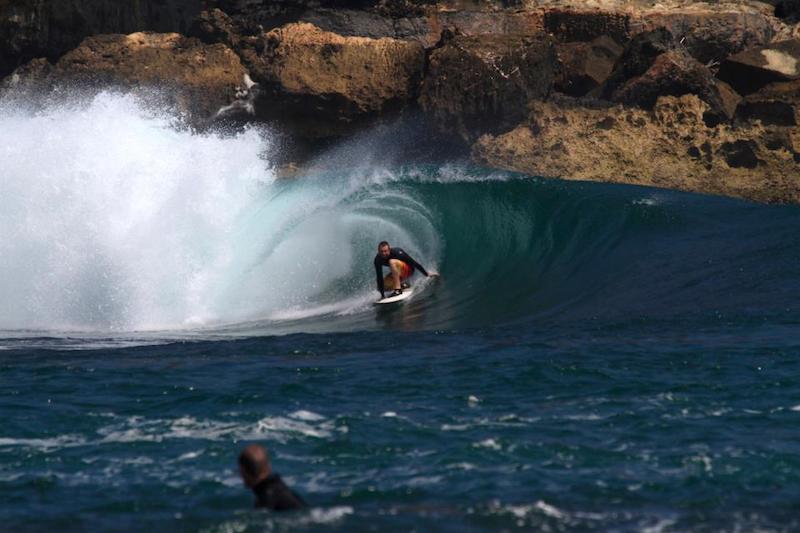If you want to look graceful, sharp and stylish in the surf, as well as avoid surfing injuries down the track, get friendly with a surf specific mobility routine.
There are many factors and reasons for reduced joint range of motion in surfers, only one of which is muscular tightness. Muscular tightness limits range of motion, preventing you from getting that full torso rotation, overhead shoulder movement, back extension, drive or quickness in your turns. Muscle tightness can lead to muscle imbalances and injury in nearby joints which compensate.
Not all stretching is created equal, and there is a load of BS out there. I also am not a fan on any sole form of yoga, although I do adopt random techniques from different yoga styles. Most forms of yoga don’t focus on individual differences, surfing imbalances or acknowledge all body areas. For example; hamstring stretching is generally hammered with minimal quadriceps stretching or the style of quadriceps stretching generally puts the knees in super flexed positions. Other body areas that receive minimal attention are the pecs, neck and forearms. Another issue is body differences – you might be someone who has an anterior pelvic tilt (over-ached lower back) and hamstrings that are already too loose, meaning to stretch the hamstrings will further destabilise your pelvis. On top of this, if you are hypermobile (women are more susceptible), stretching is not ideal for you and strength training would be the preferred alternative in keeping your body balanced. Hormonal changes within the female monthly cycle (not to mention pregnancy) also influence joint laxity/looseness so over stretching can be a problem and lead to some cranky joints.
I have taken parts of Yoga that work for me, parts of what I experienced as a dancer growing up, parts of what I have learnt with exercise physiology and also what I have learnt with physical therapy to include joint mobilisations, stretching of the muscle, stretching of the fascia and stretching of the neural structures.. where appropriate! You can find my surf mobility book here.
Why we want to stay supple for the surf – common surf injuries due to lack of joint mobility and muscle flexibility are:
NECK
When you’re paddling, which eats up the majority of time spent surfing, your neck gets pulled into hyperextension and will tighten up the muscles at the back of the neck, make you look like a turtle, lengthen your neck stabilisers at the front of your neck and stiffen your neck up.
SHOULDER
Shoulder injuries such as pinching at the front of the shoulder or tendonitis from chronic shoulder strain is a big one. Shoulder issues are commonly seen in beginners (poor paddling technique or unconditioned muscles for the amount of paddling) and older surfers (accumulated miles of paddling and imbalanced shoulder muscles). Releasing overactive and tight tissues, plus strengthening your rotator cuff muscles will prevent the prime movers pulling the arm bone upward and jamming into the shoulder joint.
LOWER BACK
Back strains / sprains are usually as a result of wipeout and the associated twists and turns forced upon the torso. In addition to this, any sudden movements have the potential to damage a poorly conditioned back as well as the strain that can develop from prolonged paddling if your butt and lower back muscles are not well conditioned, creating a shear force around the lower back and hip joint. Older surfers with poorly moving upper spines will compensate in the neck and shoulder areas.
GROIN
Inflexible adductor muscles, chronic scar tissue in adductors, poor squat technique (squatting with your knees dropping inward) and chronic tension (stress / cold / balancing on your board / standing on one leg) all add up.
KNEE
Knee injury such as medial collateral ligament (MCL) injury from the knee dropping inward is a common one. This can be avoided by a good warm-up and good conditioning. Squatting with knees over the toes, freeing up tight tissues surround the knee joint, training knee stability, leg endurance, strength and power can all help.
Once you live beyond 30 years of age, all this stuff will become more and more useful. To sum up a good injury prevention plan, start with the below:
Mobilise restricted joint areas such as the thoracic spine, shoulder, hips and ankles to avoid compensation in areas above and below.
Stretch areas found to be tight in an assessment by a physical therapist or fitness professional. My book Fluid Surfer has it’s own self-assessment chapter which can help you identify which areas you need to target rather than wasting your time with stretches you don’t need.
Get yourself a balanced strength program – balance pull to push ratios, focus on strengthening areas found weak from the right to the left, front to back and rotational aspects of your body. Train with exercises that have a functional carryover to surfing performance. Aim to correct surf-specific imbalances in the gym. For example, natural foot stance will likely develop a right rotated pelvis, goofy foot will likely develop a left rotated pelvis, therefore focus on balancing out musculature to prevent injury and early hip degeneration.
Before surfing, warm-up with dynamic stretching and mobility work. Use static, myofascial stretching and soft tissue techniques after or separate to high intensity training to balance yourself out, reduce overall muscle tension or cramping.
Ensure their nutrition is sound and supportive of their physical demands, providing the correct energy pathways and building strong bodies.
To check out more about my book on surf mobility and access the techniques I teach for surf performance and injury prevention, visit fluidsurfer.com
